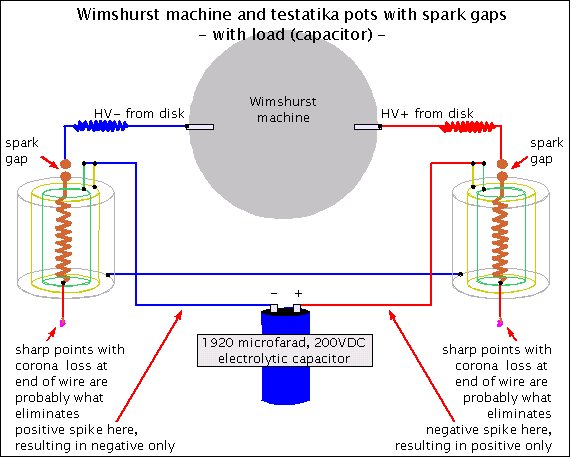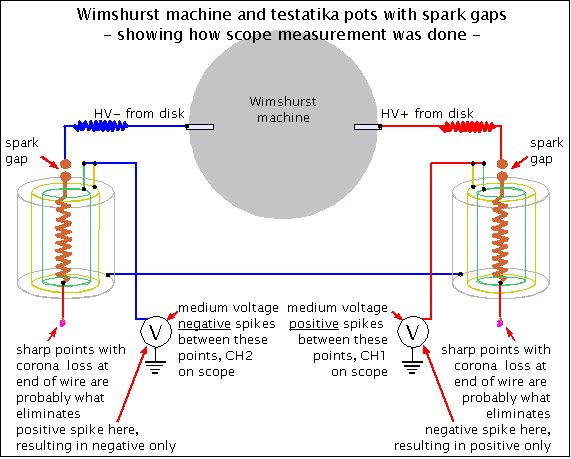Renewable Energy
Science/Electronics
Efficiency & Conservation
Composting
Food
Non-conv. Energy
Vacuum Energy
Testatika
Overview
Theories
Work Done/Author
Dissimilar metals
Pots theory 1
Pots (mk1)
Disc polarities
DC from pots
Wimshurst/sparks 1
Small machine 1Small machine 2
276mm disk, 1st grids
276mm disks, 2nd grids
1st vinyl disk
276mm disks, DC PSU 3
Magnet series 1
Magnet series 2
Magnet series 3
Wimhurst/2 sector LC
276mm wire/insul plate
Work Done/Others
Links
Old what's new
Hyde generator
EV Gray tube
Wimshurst/sparks 1
Colliding pos./VDG 1Hans Coler's devices
Roy Meyers device
SMOT mark 1
Water Wheel Mag. Motor
Test rigs
Books
Videos
Non-conv. Propulsion
Space
Stories
The objective of this experiment was to test if spark gaps could be used to pulse the intermediate grid cylinders in pots in order to tap into an energy source, thereby producing excess energy. To do this, a Wimshurst machine was used as the high voltage source but with the Wimshurst machine's spark gap and Leyden jars replaced with tetatika style pots with a spark gap at the top of each. Note that this geometry for the pots and pulsing them with a spark gap is similar to the conversion switching tube and used in Edwin V. Gray's device (see US patents 4,661,747 and also 4,595,975 and 3,890,548) though EV Gray does not make any claims in his patents for tapping of any energy source. This similarity between the testatika's pots and EV Gray's conversion switching tube has been pointed out many times over the years.
The configuration that seems to work
The following diagram shows what gave the desired result, namely DC output at the pots.
|
The whole trick in getting DC was to have the corona leakage using the sharp points at the bottom of the coil electrode that is in the middle of the pots. The above diagram shows this leakage. Without this leakage, the output consisted of alternating spikes, AC.
|
|
|
|
|
| ||
|
|
|
If the discs were spun up to around 380-400RPM then some of the spikes started to join at the top forming a more pure DC voltage output and even the bottom of the spikes moved away from the zero line producing all DC voltage as the photos below show.
|
|
|
|
|
|
I next put the capacitor in place and ran the test again while measuring on the oscilloscope. See the following photos. Note that the scope does not show the nice DC and yet the capacitor was charged from 0V (zeroed and checked before the test) to 47mV over a period of about 10 seconds with a disc speed of around 380RPM. The capacitor was a 1940microfarad, 200VDC electrolytic capacitor. Using the formula for power in a capacitor, (1/2)CV^2, that means the power in the capacitor as a result of the test was 2uW (2 microwatts). Clearly no energy source was being tapped here, or at least not in any measurable amount.
|
|
| ||
|
|
|
Other capacitor tests
At the suggestion of someone through private email, I added a second 1940uF capacitor in series with the first and ran the system with the intermediate terminals of the capacitors grounded.
|
|
|
Based on the results, see results for 2nd test below, I decided to do another test with a lower capacitance by stringing a bunch of smaller capacitors in series. The reason for using multiple capacitors is that they had a breakdown voltage of only 25V and I wanted to be able to withstand up to 200V.
|
|
Here are the results fo all three of the above capacitor combinations and some interesting calculations.
1st test: one 1940uF, 200V electrolytic capacitor
discs were rotated by hand crank 425 +/- 10 RPM for 10 seconds
- voltage on capacitor after run = 39mV
Measured total voltage = 39mV
Measured total capacitance = 1940uF
Calculated total energy in capacitor = 1.475uJ, E=1/2C(V^2)
Charge stored in capacitors = 75.7uC, Q=CV
2nd test: two 1940uF, 200V electrlytic capacitors in series
discs were rotated by hand crank 425 +/- 10 RPM for 10 seconds
- voltage on right capacitor after run (CH1 on scope picture above) = 40mV
- voltage on left capacitor after run (CH2 on scope picture above) = 42mV
Measured total voltage = 82mV
Measured total capacitance: 1/Ct = 1/C1 + 1/C2, Ct = 970uF
Calculated total energy in capacitors = 1/2(C)(V^2) = 3.26uJ, E=1/2C(V^2)
Charge stored in capacitors = 79.5uC, Q=CV
3rd test: 8 22uF,25V electrolytic capacitors in series
discs were rotated by hand crank 425 +/1 10 RPM for 10 seconds
- voltage across all capacitors after run = 15.8V
Measured total voltage = 15.8V
Measured total capacitance: 1/Ct = 1/C1 + ... + 1/C8, Ct = 2.75uF
Calculated total energy in capacitors = 343uJ, E=1/2C(V^2)
Charge stored in capacitors = 43.5uC, Q=CV
Notes: The 3rd test was done 2 days after the other two. Also, even though
the capacitances for the 2nd and 3rd tests above are calculated, the
individual capacitances were checked by measurement.
The reason for the higher energy capture is simply because of the decreased capacitances. This is expected since by decreasing the capacitance you will generate more voltage within the capacitor for every charge you put on the capacitor plates (the resulting V in C=Q/V is larger for smaller capacitances.) Another way of thinking of it is that for every charge put on the plates of the capacitor, a stronger electric field will be generated between those charges. Being able to generate more voltage is like having a spring that you can stretch more, all other things being equal. You're storing more energy in the spring for when you release it, just as you're storing more energy in the capacitor for when you discharge it. So we're just changing the capacitors so we can store more of the available energy. Nothing here indicating that we are generating more energy.
Conclusion
The small amount of charging of the capacitor above demonstrates that there is definately no energy source being tapped here.







